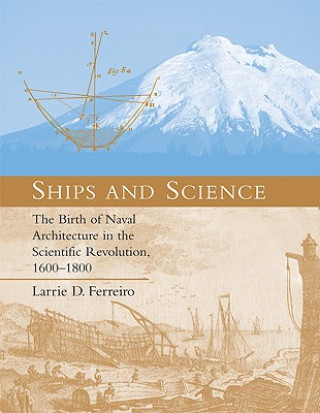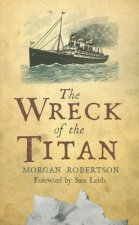
Kód: 04561571
Ships and Science
Autor Larrie D. Ferreiro
"Naval architecture was born in the mountains of Peru, in the mind of a French astronomer named Pierre Bouguer who never built a ship in his life." So writes Larrie Ferreiro at the beginning of this pioneering work on the science ... celý popis
- Jazyk:
 Angličtina
Angličtina - Vazba: Brožovaná
- Počet stran: 472
Nakladatelství: MIT Press Ltd, 2010
- Více informací o knize

1137 Kč
Dostupnost:
50 % šance Máme informaci, že by titul mohl být dostupný. Na základě vaší objednávky se ho pokusíme do 6 týdnů zajistit.
Máme informaci, že by titul mohl být dostupný. Na základě vaší objednávky se ho pokusíme do 6 týdnů zajistit.Prohledáme celý svět
Mohlo by se vám také líbit
-

All Our Hidden Gifts
268 Kč -

Jurassic Park
290 Kč -

The Electric State
706 Kč -

Wild at Home
531 Kč -

G.O.A.T. - Lebron James
203 Kč -

Game Changer
566 Kč -

Halo: The Fall of Reach: Volume 1
401 Kč -

Madonna in a Fur Coat
290 Kč -

Women Don't Owe You Pretty
433 Kč -

Chinese Air Power
1314 Kč -

Unsettled
496 Kč -

Reality transurfing. Steps I-V
1793 Kč -

Blood on the Tracks 6
282 Kč -

Certified Kubernetes Application Developer (CKAD) Study Guide
1126 Kč -

Eminence in Shadow, Vol. 3 (light novel)
407 Kč -

Practical Tips on How to Contract: Techniques and Tactics from an Ex-BigLaw and Ex-Tesla Commercial Contracts Lawyer
384 Kč -

Sino-Soviet Border War of 1969, Volume 1
853 Kč -

Modern Software Engineering
929 Kč -

Gilmore Girls: The Official Cookbook
761 Kč -

Mermaids and Animal Companions Coloring Book
321 Kč -

Anatomy: A Love Story
410 Kč -

Fundamentals of Data Engineering
1718 Kč -

Kanji From Zero! 2
1042 Kč -

Demon Slayer: Kimetsu no Yaiba-One-Winged Butterfly
223 Kč -

Starting Out : The Accelerated Dragon
570 Kč -

Gathering Moss
400 Kč -

2,286 Traditional Stencil Designs
348 Kč -

Victorian Floral Illustrations
382 Kč -

World's Greatest Blackjack Book
351 Kč -

Harry Potter and the Chamber of Secrets
487 Kč -

Art of Application Performance Testing 2e
877 Kč -

Story of King Arthur and His Knights (Barnes & Noble Collectible Classics: Children's Edition)
678 Kč -

Keepers of the Light Oracle Cards
568 Kč -

Road to Serfdom
429 Kč -

100 Tips for Hoteliers
361 Kč -

Only Love Is Real
357 Kč -

Japanese from Zero! 2
1016 Kč -

Hours
268 Kč -

Star Trek: The Art of the Film
538 Kč -

Little Book of Language
336 Kč -

Sindbad the Sailor
62 Kč -

Jesus Calling, Padded Hardcover, with Scripture References
356 Kč -

Propaganda Front
1003 Kč -

How to Diagnose and Fix Everything Electronic, Second Edition
603 Kč -

World is Full of Foolish Men
90 Kč -

Selection
421 Kč -

CATIA V5 Tutorials Mechanism Design & Animation Release 21
2233 Kč -

Emotion-Focused Therapy
1168 Kč -

Sex: A Man's Guide
320 Kč -

Ry Sai Kenbo: The Educational Ideal of 'Good Wife, Wise Mother' in Modern Japan
3616 Kč -

El Greco
264 Kč -

Das große Stickerhaus
183 Kč -

Bóg Imperator Diuny. Kroniki Diuny. Tom 4 wyd. 2022
272 Kč -

Kupka Monographie
456 Kč -

Spowiedź Hitlera 2 Szczera rozmowa po 20 latach
280 Kč -

Meine Wortschatz-Wunderkiste
333 Kč
Darujte tuto knihu ještě dnes
- Objednejte knihu a zvolte Zaslat jako dárek.
- Obratem obdržíte darovací poukaz na knihu, který můžete ihned předat obdarovanému.
- Knihu zašleme na adresu obdarovaného, o nic se nestaráte.
Informovat o naskladnění knihy
Zadejte do formuláře e-mailovou adresu a jakmile knihu naskladníme, zašleme vám o tom zprávu. Pohlídáme vše za vás.
Více informací o knize Ships and Science
Nákupem získáte 114 bodů
 Anotace knihy
Anotace knihy
"Naval architecture was born in the mountains of Peru, in the mind of a French astronomer named Pierre Bouguer who never built a ship in his life." So writes Larrie Ferreiro at the beginning of this pioneering work on the science of naval architecture. Bouguer's monumental book Trait du navire (Treatise of the Ship) founded a discipline that defined not the rules for building a ship but the theories and tools to predict a ship's characteristics and performance before it was built. In Ships and Science, Ferreiro argues that the birth of naval architecture formed an integral part of the Scientific Revolution. Using Bouguer's work as a cornerstone, Ferreiro traces the intriguing and often unexpected development of this new discipline and describes its practical application to ship design in the seventeenth and eighteenth centuries. Drawing on previously untapped primary-source and archival information, he places the development of naval architecture in the contexts of science, navy, and society, across the major shipbuilding nations of Britain, France, Spain, the Netherlands, Sweden, Denmark, and Italy.Ferreiro describes the formulation of the three major elements of ship theory (the science of explaining the physical behavior of a ship): maneuvering and sail theory, ship resistance and hydrodynamics, and stability theory. He considers the era's influential books on naval architecture and describes the professionalization of ship constructors that is the true legacy of this period. Finally, looking from the viewpoints of both the constructor and the naval administrator, he explains why the development of ship theory was encouraged, financed, and used in naval shipbuilding. A generous selection of rarely seen archival images accompanies the text.
 Parametry knihy
Parametry knihy
Zařazení knihy Knihy v angličtině Humanities History History: specific events & topics
1137 Kč
- Plný název: Ships and Science
- Podnázev: The Birth of Naval Architecture in the Scientific Revolution, 1600-1800
- Autor: Larrie D. Ferreiro
- Jazyk:
 Angličtina
Angličtina - Vazba: Brožovaná
- Počet stran: 472
- EAN: 9780262514156
- ISBN: 026251415X
- ID: 04561571
- Nakladatelství: MIT Press Ltd
- Hmotnost: 760 g
- Rozměry: 228 × 178 × 23 mm
- Datum vydání: 22. January 2010
Oblíbené z jiného soudku
-

Man's Search for Meaning
175 Kč -

Women, Race & Class
290 Kč -

Pianist
279 Kč -

Out Of Place
303 Kč -

Little History of Economics
350 Kč -

Laughter in Ancient Rome
501 Kč -

Civilization and Capitalism, 15th-18th Century
1634 Kč -

Armies of Medieval Burgundy 1364-1477
394 Kč -

Night
249 Kč -

Society of the Spectacle
291 Kč -

Imperialism: The Highest Stage of Capitalism
196 Kč -

Man's Search For Meaning
410 Kč -

Homo Deus
274 Kč -

Ordinary Men
323 Kč -

Black Earth
378 Kč -

The Complete MAUS
487 Kč -

The Rape of Nanking
476 Kč -

Madness and Civilization
419 Kč -

Conquerors
323 Kč -

Stoned
276 Kč -

Twelve Years a Slave
90 Kč -

At Home
303 Kč -

Origins of Museums
1489 Kč -

Measure of a Man
373 Kč -

Delirious New York
715 Kč -

Eichmann in Jerusalem
323 Kč -

Mein Kampf - The Ford Translation
1005 Kč -

Bloodlands
378 Kč -

Guns, Germs and Steel
378 Kč -

Cold War Submarines
910 Kč -

Fall of Public Man
410 Kč -

Che Guevara
547 Kč -

Dancing In The Streets
303 Kč -

Fix the Pumps
361 Kč -

Blue
964 Kč -

Revolutionary Yiddishland
335 Kč -

Commandant Of Auschwitz
302 Kč -

Jewish State
289 Kč -

Eichmann in Jerusalem
382 Kč -

Reflections on the Revolution in France
249 Kč -

Wall Street and the Bolshevik Revolution
357 Kč -

Corgi Toys
461 Kč -

Night
276 Kč -

Wreck of the Titan
322 Kč -

McMafia
302 Kč -

Intimate History of Humanity
356 Kč -

Feminism: A Very Short Introduction
250 Kč -

White Gold
357 Kč -

Twelve Who Ruled
599 Kč
Osobní odběr Praha, Brno a 12903 dalších
Copyright ©2008-24 nejlevnejsi-knihy.cz Všechna práva vyhrazenaSoukromíCookies


 Vrácení do měsíce
Vrácení do měsíce 571 999 099 (8-15.30h)
571 999 099 (8-15.30h)